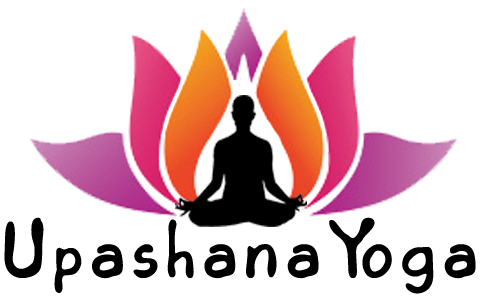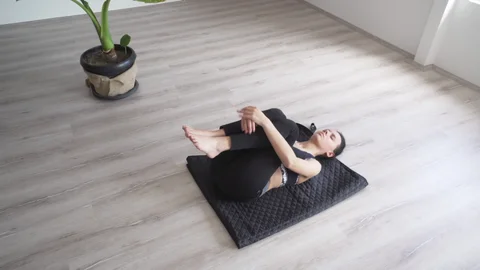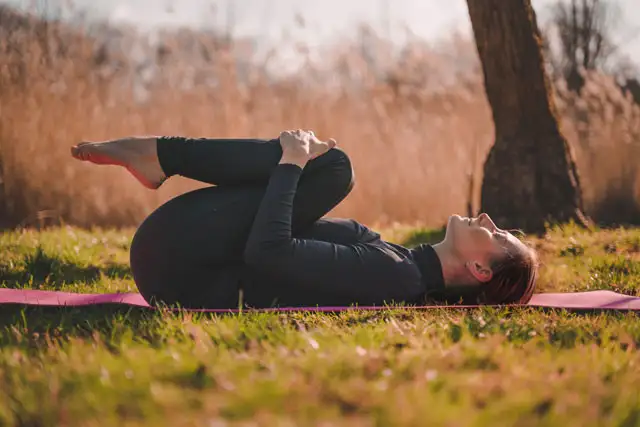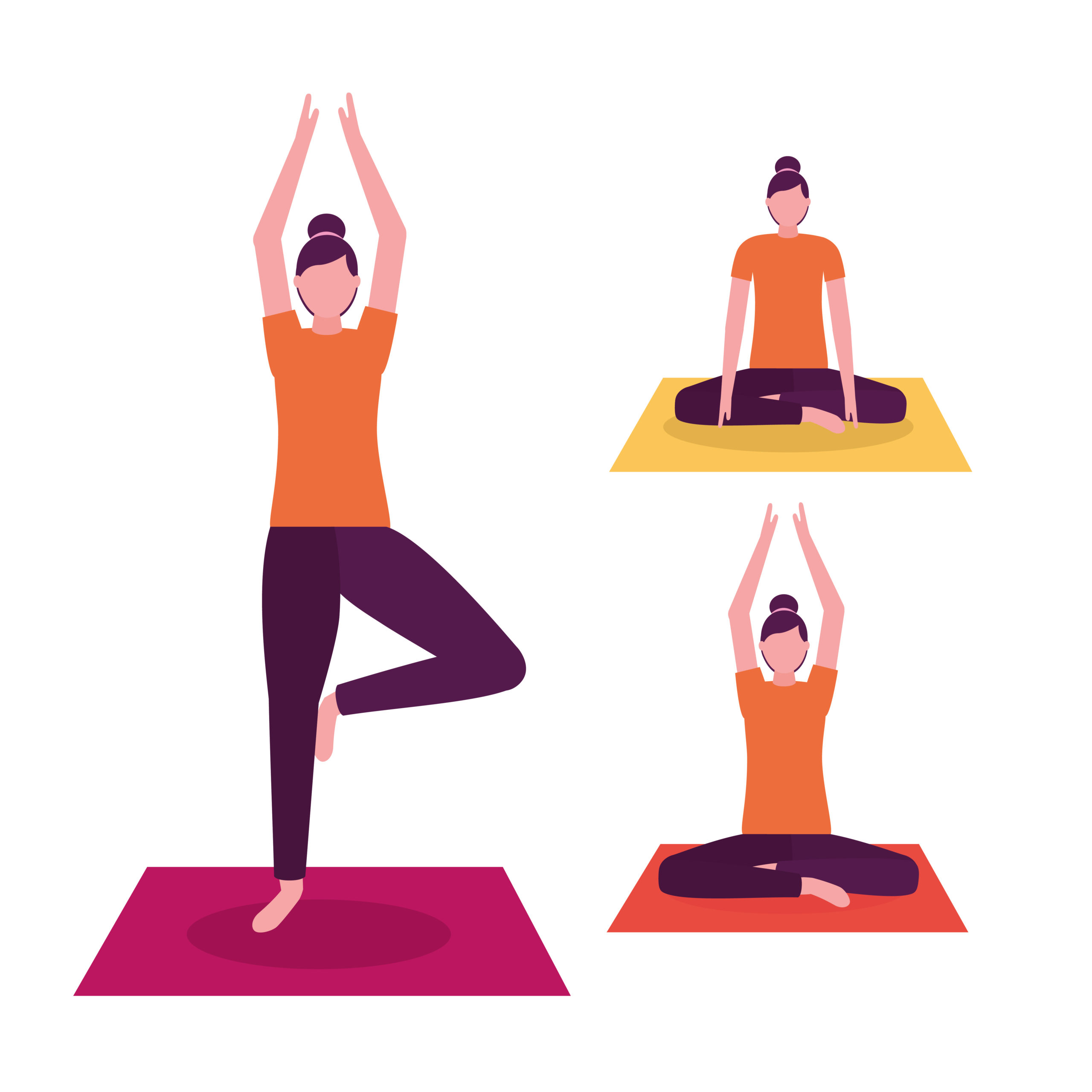Pawanmuktasana often called “Wind‑Releasing Pose” or “Gas Release Pose” is a gentle reclining asana widely used in yoga practices to support digestion, remove trapped gas, and release tension in the the lumbar spine and abdominal region. It is especially helpful as a preparatory or cooling posture, and is safe enough for many levels of practitioners. Pawanmuktasana or Wind Releasing Pose can support internal organs, calm the mind, and help maintain a comfortable, balanced digestive system.
What is Pawanmuktasana or Wind Releasing Pose?
The name comes from Sanskrit: Pawan (wind, gas) + Mukta (release) + Asana (posture). Thus, Pawanmuktasana literally means “pose to release wind (gas).” It is also called the “Wind Release Pose.”
In practice, it involves bringing one or both knees toward the chest, sometimes lifting the head to touch the knee, thereby applying gentle pressure on the abdomen and lower back, which helps move and release trapped gas and stimulates digestion.
(Also Read: Ardha Chandrasana Or Half Moon Pose Steps & Benefits)
Preparation Poses Of Pawanmuktasana or Wind Releasing Pose:
Though Pawanmuktasana is relatively gentle, preparing the body helps:
- Supta Tadasana/Supine Relaxation lying flat, letting the spine and abdomen soften.
- Gentle Supine Twists rotate legs side to side to loosen the lower back and massage the lumbar region.
- Knees to Chest (without lifting head) simply hug knees to the chest without raising the head, to familiarize the movement.
- Leg Raises/Ankle Rotations to mobilize hips, pelvis, and legs.
- Pelvic Tilts/Bridge Preparations to activate the lower back and support gentle compression.
These preparatory movements relax the abdominal cavity, ready the spine, and reduce strain when you bring your knees in or lift your head.
(Also Read: Kumbhakasana Or Plank Pose Steps & Benefits)
Steps To Do Pawanmuktasana or Wind Releasing Pose:
Below is a typical approach, with optional variations. Adapt to your comfort and body limits.
Lie Down:
Begin by lying flat on your back (supine) with legs extended, arms resting by the sides, and body relaxed. Take a few natural breaths and let the spine settle.
Bring One Knee to Chest:
On an exhale, bend your right knee and bring it toward your chest. Use your hands (or interlock fingers) to hold the shin just below the knee, gently pressing the thigh against the abdomen. Keep the left leg extended on the floor.
Lift Head & Chest:
From here, you may inhale, then on the next exhale gently lift your head and upper chest so that your chin or nose comes toward the knee. Use awareness — don’t overstrain your neck.
Hold the Pose/Breathe:
Remain in this pose for a few breaths (5–6 or as comfortable), maintaining mild pressure on the abdomen. With each exhale, you may deepen the hug slightly; with inhalation, you may relax the grip.
Release and Return:
Slowly lower your head down (if lifted), release your hands, and extend the leg back down to the mat, returning to the supine base position.
Repeat on Other Side:
Repeat the same sequence with the left knee coming to the chest.
Both Legs Variation:
After doing one side at a time, you can do a variation with both legs bent simultaneously — bring both knees to the chest, clasp below the knees, lift head and chest if comfortable, then release.
Optional Rocking/Rolling:
Some traditions allow gentle rocking or rolling side to side or forward/backwards for a mild spinal massage before final release.
(Also Read: Sirsasana Or Headstand Steps & Benefits)
Follow-Up Poses After Pawanmuktasana or Wind Releasing Pose:
After practicing Pawanmuktasana, you might choose poses that continue to relax, stretch, or counterbalance the body:
- Savasana or Corpse Pose to rest and integrate the effects.
- Supine Twist or Supta Matsyendrasana gentle spinal twist helps release residual tension.
- Setu Bandha Sarvangasana or Bridge Pose gentle back extension to balance the forward compression.
- Happy Baby or Ananda Balasana opens hips and stretches the lower back.
- Legs-Up-the-Wall or Viparita Karani restores circulation, gives a relaxed inversion.
- Child’s Pose or Balasana calms and lengthens the spine.
These postures help maintain balance in the body, promote further relaxation, and let the digestive and nervous systems absorb the benefits.
(Also Read: Dhanurasana Or Bow Pose Steps & Benefits)
Benefits Of Pawanmuktasana or Wind Releasing Pose:
The benefits of Pawanmuktasana or Wind Releasing Pose are…
Pawanmuktasana or Wind Releasing Pose Relieves Gas & Bloating/Aids Digestion:
The gentle pressure on the abdomen and colon in Pawanmuktasana helps stimulate movement in the intestines, facilitating the release of trapped gas, reducing bloating, and improving digestion.
Pawanmuktasana or Wind Releasing Pose Strengthens Abdominal & Back Muscles:
Hugging the knees toward the torso engages the abdominal muscles; the gentle lift of the head and chest (if done) activates the spinal extensors and musculature supporting the lower back. This helps stabilize and tone the core.
Massages Internal Organs:
The compression of thighs against the abdomen stimulates circulation in the digestive organs (liver, intestines, pancreas) and helps in detoxification or elimination.
Loosens the Lumbar Spine/Releases Tension:
Bringing knees to the chest gently lengthens and relaxes the lumbar vertebrae, reduces stiffness in the lower back, and helps relieve discomfort.
Supports Reproductive & Pelvic Health:
The pose exerts mild stimulation to pelvic organs, which can support menstrual health, improve blood flow in the pelvis, and assist with mild reproductive discomfort.
Calms the Mind & Reduces Stress:
Since the pose is gentle and restorative, it encourages mindful breathing and helps the parasympathetic nervous system activate, reducing anxiety, calming the mind, and promoting internal balance.
Helpful for Constipation/Intestinal Disorders:
Because it stimulates peristaltic action (intestinal movement) and helps remove trapped gas, this asana is often recommended for mild cases of constipation or sluggish digestion.
(Also Read: Navasana Or Boat Pose Steps & Benefits)
Precautions of Pawanmuktasana or Wind Releasing Pose:
Even though Pawanmuktasana is relatively safe for many people, there are several precautions and contraindications to keep in mind:
- Hernia or Abdominal Surgery: Avoid or practice under supervision, since the pressure on the abdomen may aggravate or irritate the condition.
- Severe Back or Spine Issues / Disc Problems: Those with serious lower back injuries or disc herniations should avoid bending forward or lifting the head, or skip the pose altogether unless cleared.
- Neck Injuries: If neck support is weak or injured, avoid lifting head or keep it down to prevent straining.
- High Blood Pressure / Heart Conditions: Because the pose involves compressions and moderate exertion, those with uncontrolled hypertension or heart conditions should be cautious and consult a physician.
- Pregnancy: Especially in the later trimesters, avoid this pose (especially lifting the head or compressing the abdomen).
- Menstruation/Pelvic Issues: Some sources recommend avoiding or modifying the pose during menstruation or in presence of pelvic pain or testicular disorders.
- Neck, Knee, Hip Pain: If these joints are sensitive, modify, keep head down, bend knees more, or skip lifting portions.
- Avoid Force/Strain: Never force the knee fully or jerk the body; move gently with the breath and within your capacity.
Always listen to your body. If pain arises (not a gentle stretch but sharp or injury‑type), ease out. For chronic medical conditions, consult a qualified medical professional or experienced yoga teacher before performing this asana.
(Also Read: Bakasana Or Crane Pose Steps & Benefits)
Conclusion:
Pawanmuktasana or Wind Releasing Pose is a deceptively simple yet powerful yogic posture that supports digestive health, relieves gas and bloating, soothes the lumbar spine, and helps calm the mind. Because of its gentleness and adaptability, it suits many levels of practitioners and can be included early or late in the yoga practice. When practiced with awareness, respect for limits, and proper alignment, it offers cumulative benefits for both body and mind. However, like any practice, it requires caution in the presence of injuries or health conditions, and modification is always better than force.
FAQ:
Q. When is the best time to practice Pawanmuktasana?
A. Ideally, practice it on an empty stomach—either early morning or at least a few hours after a meal. It can be done as a warm-up before other asanas or as a relaxation/cleansing pose during or after a session.
Q. How long should I hold the pose?
A. Start with 10–20 seconds (or 2–3 breaths) per side, and gradually extend up to 30–60 seconds (5–6 breaths), as comfortable.
Q. Must I lift my head to touch knee?
A. No. Lifting the head is optional and should only be done if your neck is comfortable. If you have neck issues, keep the head on the mat and hug the knee gently.
Q. Can I skip doing both legs together?
A. Yes. Many practitioners do one leg at a time. Doing both legs is an advanced variation — you should only do that when comfortable with single‑leg versions.
Q. Will this pose help with constipation?
A. Yes; one of the key therapeutic uses of Pawanmuktasana is to stimulate digestion and relieve constipation by applying gentle abdominal pressure and promoting intestinal movement.
Q. How often should I practice it?
A. You can do it daily (or almost daily), especially during digestive discomfort or bloating. But always respect your body’s rest days too.
Q. What if I feel discomfort in my back or neck?
A. If discomfort arises, ease the pose: keep head down, bend knees more, reduce lift, or rest entirely. Avoid forcing or pushing.













Leave a Comment